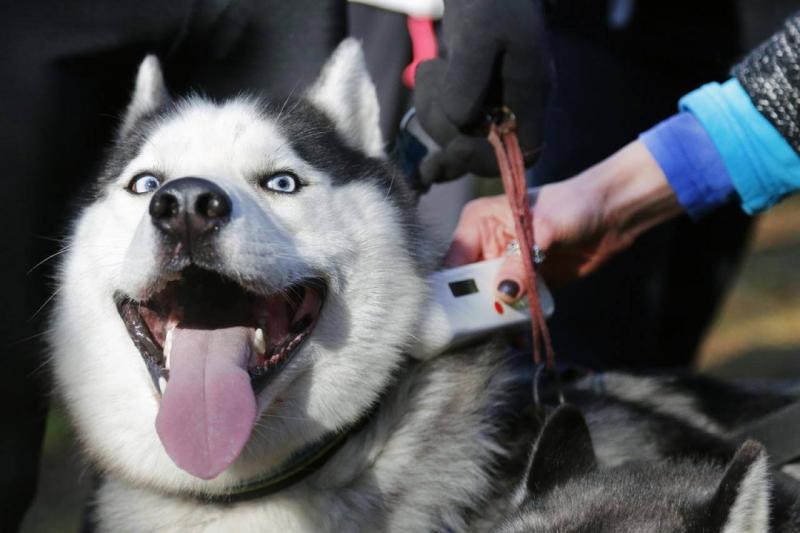
Around 250,000 pets go missing every year in the UK. Microchipping makes it easier to reunite these missing pets with their owners.
It’s been a legal requirement to microchip all dogs in England and Wales since April 2016, and it'll soon be the law for cats.
You can microchip animals such as rabbits, ferrets and parrots too.
We've put together this comprehensive guide to help you get to grips with microchips.
What is microchipping?
A microchip is a scannable, small device roughly the size of a grain of rice.
It stores information like your name and address on a database so the police or local authority can contact you if your pet is lost.
Microchipping is a safe, simple procedure for animals. Your vet, or a trained professional, will implant a small electronic device under your pet’s skin, usually where the skin is loose between the shoulder blades.
It’s a quick procedure that doesn't cause your pet pain or discomfort once it's in place.
A microchip lasts a lifetime, but you must update the information if you change address or the animal gets a new owner.
Microchipping aims to tackle the high numbers of stray, abandoned and injured pets.
Along with reuniting families with their pets, it's thought that microchipping dogs can also help prevent illegal breeding and puppy farms, as the chip is linked to the breeder.
What’s the law around microchipping my cat or dog?
Since April 2016, it’s been compulsory to microchip dogs in England, Scotland and Wales unless a vet certifies they’re exempt for health reasons.
Since 2016, Cats Protection (the UK’s leading cat charity) and other animal welfare organisations have successfully campaigned for compulsory microchipping legislation for cats. This law will extend to cats in late 2022.
When do I need to microchip my cat or dog?
Puppies must be microchipped once they turn eight weeks old. Cats must be microchipped by the time they’re 20 weeks old.
You also must keep the contact details stored on the microchip database updated.
If you don’t microchip your pet, police or local authorities will give you 21 days to do so, or you could face a £500 fine.
Where can I get my pet microchipped, and how much does it cost?
Veterinary surgeries, pet shops and pet rescue and welfare centres can all fit microchips.
Wherever you decide to take your pet, make sure that you use a fully qualified professional – it’ll help protect your insurance claim if something goes wrong.
It isn't expensive to microchip your pet, but costs vary depending on where you have the procedure.
Some charities, such as Dogs Trust or other animal welfare centres, may microchip your pet for free or ask for a small donation.
How do I find out if my adopted pet is already microchipped?
If you’re not sure, you can get your pet scanned at an animal shelter, vet or even a police station.
You won’t need an appointment, and they shouldn’t charge you.
If you’ve rehomed your pet from a shelter, it’s likely that the rescue organisation will have microchipped the animal.
If this is the case, you must add your details to the microchipping database.
How do I update my pet's microchip?
Updating your pet’s microchip will cost you around £10, and the process depends on which database your chip manufacturer is registered with.
If you got an update form when you first microchipped your pet, you can fill it out and post to the company.
You may be able to update your details with your database provider online or over the phone.
If you're unsure which database you registered your details with, contact your vet or take your pet into a veterinary clinic or pet shop to be scanned. You can also use check-a-chip.co.uk to find out.
What should I do if my pet goes missing?
Microchips can only reveal information from a database once scanned. It doesn’t use GPS technology, so you can’t locate your missing pet.
If your pet doesn't come home, hopefully someone has taken them to an animal rescue centre or an animal warden.
They’ll scan the microchip and contact you, which is why keeping the contact details on the microchip up to date is essential.
If your pet is missing for a while, ask your local centres to keep their eyes peeled for your pet.
How does microchipping affect my pet insurance?
Most insurers will ask you whether your pet is microchipped to determine your premium.
If you own a dog, you can’t get dog insurance until you've had it microchipped.
If you own a different animal, insurers may offer a discount for getting it microchipped.
I’ve spent 20 years writing about pets and exploring the wonderful relationships they have with their owners. I started as a staff writer on Dogs Today magazine, working my way up to become deputy editor in 2008. In 2010, I left the office to pursue a freelance career, relocated to north Norfolk and started a family.
Over the years I’ve contributed thoughtful human-interest features, celebrity interviews and investigative news stories to publications including The Sunday Times, Dogs Today, Dogs Monthly and Your Cat. I’ve also ghost-written veterinary books and press releases for the pet industry.
When I’m not writing, I enjoy long walks in the Norfolk countryside with my rescue lurcher Popsie. These are always followed by tea and cake.



